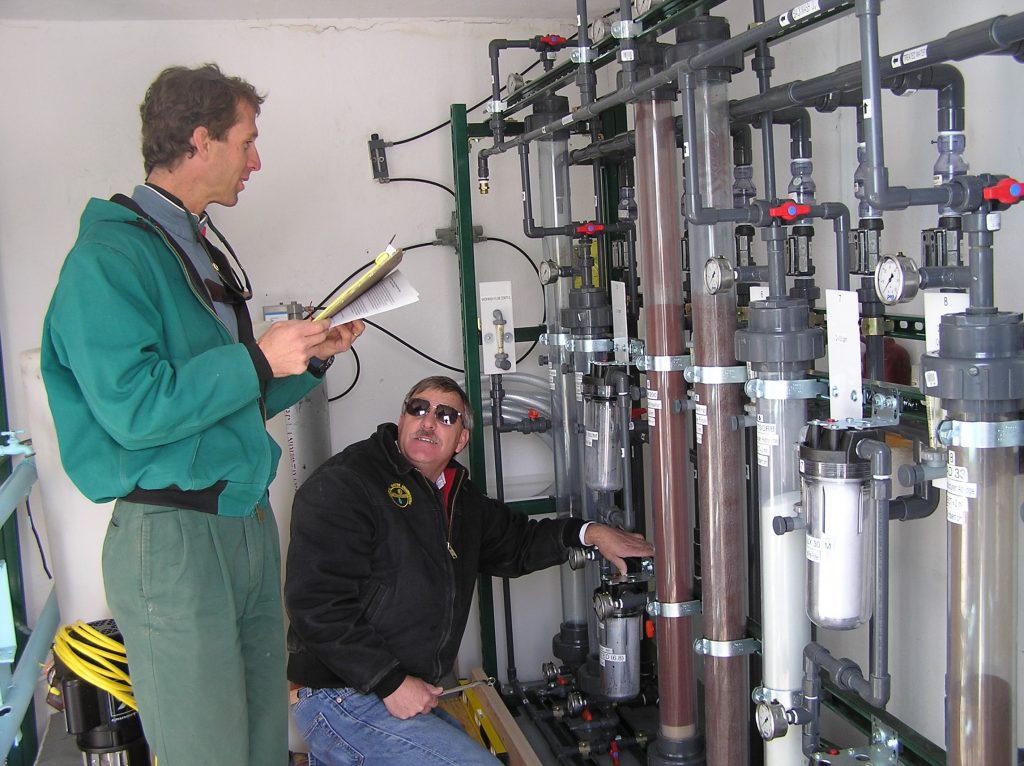
Download 300dpi JPEG image, ‘water-pic.jpg’, 596K (Media are welcome to download/publish this image with related news stories.)
ALBUQUERQUE, N.M. — Over the next few weeks researchers at the National Nuclear Security Administration’s Sandia National Laboratories will begin testing innovative ways to treat arsenic-contaminated water in an effort to reduce costs to municipalities of meeting the new arsenic standard issued by the U.S. Environmental Protection Agency (EPA).
The testing is sponsored by the Arsenic Water Technology Partnership (AWTP), a multiyear-program funded by a congressional appropriation through the U.S. Department of Energy.
“The goals of the program are to develop, demonstrate, and disseminate information about cost-effective water treatment technologies in order to help small communities in the Southwest and other parts of the country comply with the new EPA standard,” says Malcolm Siegel, Sandia Arsenic Treatment Technology Demonstration Project Manager.
The tests will be conducted at a geothermal spring used to supply drinking water to Socorro, N.M., a town of about 9,000 residents located 80 miles south of Albuquerque. Installation of test equipment will be completed in December by Sandians Randy Everett and Brian Dwyer, and regular operations will begin before Christmas following a preliminary “shakedown” period. Another member of the team, Alicia Aragon, will present results of laboratory studies supporting the pilot tests at the Fall Meeting of the American Geophysical Society in San Francisco next week.
AWTP members include Sandia, the Awwa Research Foundation (AwwaRF), and WERC, a Consortium for Environmental Education and Technology Development.
The Awwa Research Foundation is managing bench-scale research programs. Sandia will conduct the demonstration program, and WERC will evaluate the economic feasibility of the technologies investigated and conduct technology transfer activities.
Congressional support and design of the Arsenic Water Technology Partnership was developed under the leadership of U.S. Sen. Pete Domenici, R-N.M., to help small communities comply with the new EPA drinking water standard for arsenic. The new regulation, which will go into effect in January 2006, reduces the Maximum Contaminant Level (MCL) from 50 micrograms per liter (µg/L) to 10 µg/L and is designed to reduce the incidence of bladder and lung cancers caused by exposure to arsenic.
Levels of naturally occurring arsenic in the Southwestern U.S. often exceed the new MCL. The new compliance requirements will impact small communities in the country that lack the appropriate treatment infrastructure and funding to reduce arsenic to such levels.
The pilot test in Socorro will compare five innovative technologies developed by universities, small businesses, and large well-established water treatment companies and should last about nine months. These treatment processes were chosen from more than 20 candidate technologies that were reviewed by teams of technical experts at Arsenic Treatment Technology Vendor Forums organized by Sandia and held at the 2003 and 2004 New Mexico Environmental Health Conferences.
Sandia is developing plans for future tests in rural and Native American communities in New Mexico and other parts of the country. These additional sites will be chosen through consultation with a number of agencies including the New Mexico Environment Department, the EPA, the Indian Health Service, the Navajo Nation EPA, and the Interstate Technology Regulatory Council. In addition, the AWTP will post a website application where interested communities can ask to be considered for a pilot.
The demonstrations will involve additional technologies reviewed at the vendor forums and others developed from the laboratory studies managed by AwwaRF. Educational forums will be organized by WERC at the start of a pilot demonstration to introduce community members to the program and after the test is completed to describe the test results. The first forum will be held on Dec. 15 as part of the meeting of the New Mexico Rural Water Association at the Holiday Inn Express in Socorro.